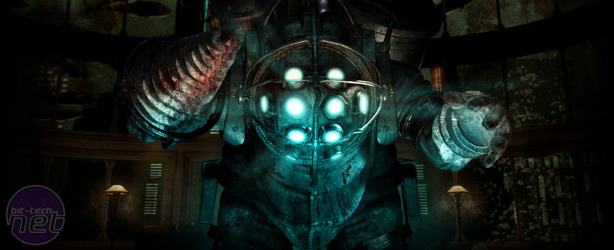
The Immortal
First, there is the respawn. This is a case where there is still a death state, but instead of it being ignored it’s integrated into the canon. Bioshock, for example, had its Vita-Chambers: an instant respawn that happened at a checkpoint while retaining your damage and ammo levels. It meant that killing the iconic big daddies could just come down to a slow war of attrition, because you come back with full health whereas enemies are still damaged from your last wrench-flurry.Rumours go that bit-tech readers aren’t the biggest fans of Bioshock and that the Vita-Chambers were a large part of the problem - and it comes down to a valid point. Really, the respawn here is just a more elaborate, easier version of the fail state. You re-tread ground to get back to where you were and try to kill something again, only this time it’s easier because you already had a go once.
The slightly underappreciated Prey had a similar feature. When you died, you went to a netherworld... where you shot arrows at big bats... to regain health... to come back to life. It makes more sense in context. Here you didn’t have to jog back to where you were to carry on. Instead your 'time to get back to the action' was spent shooting bats. Is that better? I don’t even know.
The respawn might not be looking great about now then, but there have been a few times where it’s really worked. Planescape: Torment, for example, respawns the player back in a mortuary and forces them to escape again, but this is a game where the player is an immortal. The cycle of death is integral to the plot. Infinity Blade embraces the respawn too, making it a feature rather than a mechanism by having the player respawn at the start as a child of the character who just died - inheriting all of their equipment and skills.
Meanwhile, Prince of Persia: The Sands of Time just undoes death, making it part of the narrator's canon – ‘oh no, I got that wrong, that’s not what happened,’ says the Prince. Really though, the best instance of the respawn is in Left 4 Dead.
Not only is the death process in L4D often hilarious-sometimes-heroic - 'LEAVE ME AND GO!' - but it also gives plenty of opportunity for the person to be saved. If that fails, and the person dies, then they respawn a bit further on in the level to be saved by the remaining survivors. Of course, if everyone dies then we hit the fail state, but it’s a lot harder to hit that point. By making death/near-death an event that creates bonds between players, and using a progressive respawn that shapes the narrative, we get a death state that's often a highlight and which produces stories to be retold around the campfires of the Internet.
Close to the respawn is the embrace. It’s like a super respawn. Instant. It’s for when death is an absolute inevitability. The developers are 100 per cent certain that you're going to mess up over and over and over again, so they implement hyper checkpointing with an instant retry system. The embrace is for the games that you enjoy making you angry: the sado-masochist games. Super Meat Boy, Trials 2, VVVVVV; they all do exactly the same thing - derivatives from the original platformers but without the number of lives counting down to a fail state.
Death with the embrace isn’t canon because a narrative barely exists. Death is the focus, the challenge, the enemy to overcome. As you commit each section of a level to muscle memory, you steadily beat death. It becomes more than trivial because it’s wholly accepted. 'Oh I died. Oh I died. Died. Died. Dead.' The death state exists for a micro-second before the stage is reset and everything is as it was - the player close to immortal because death has no significance. Clearly this only works in a game in which this concept is the very focus - but it’s a death mechanic none the less.
The embrace is very different from the immortal state though, even though both couldn’t care less about the death state. The immortal state is where you just can’t die. It’s very rare to see this outside of adventure games really - classics such as Monkey Island right up to more modern approaches such as Machinarium plainly don’t put the player into a position where they can be killed. And this is fine, perfect in the situation really, but they’re a different breed of game where there can only ever be progression.
Then came Peter Molyneux.

MSI MPG Velox 100R Chassis Review
October 14 2021 | 15:04











Want to comment? Please log in.